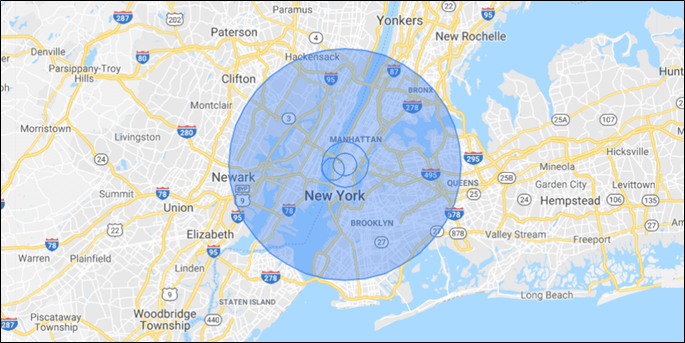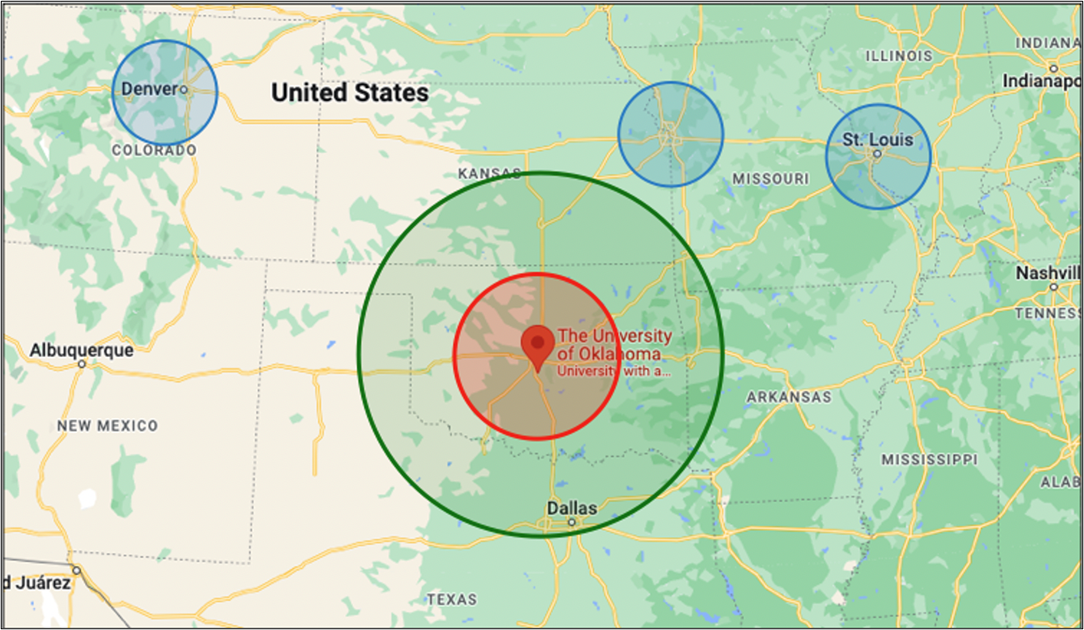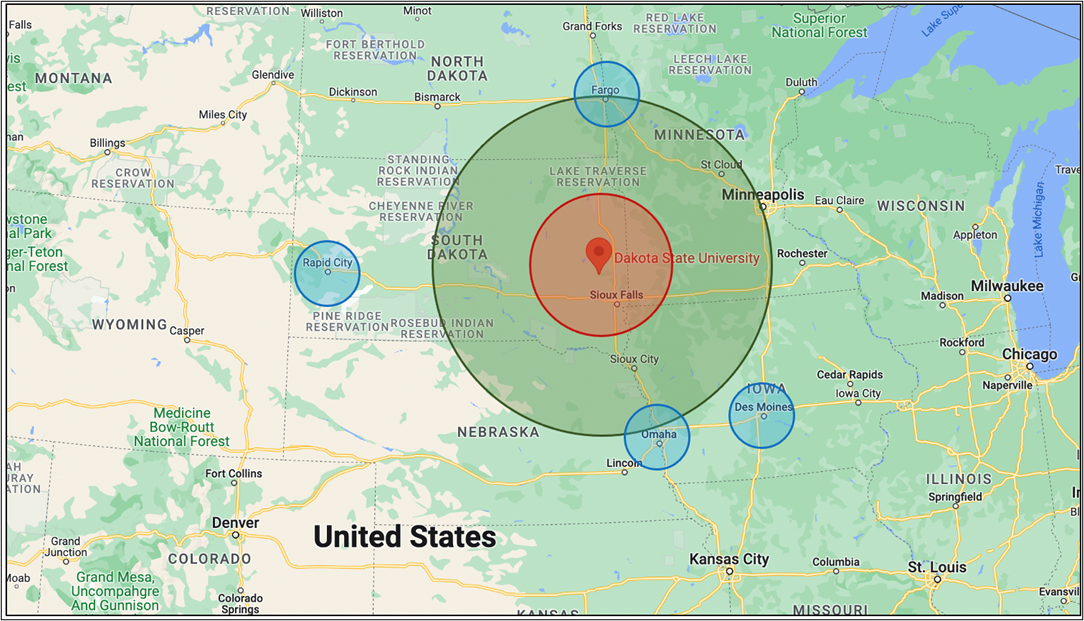How many students are coming from your own backyard? And… How much are you paying for those students to come to your school?
Geography targeting for student recruitment strategies are a vital part in not only attracting more students to a school, but also a way to help create efficiencies within your marketing budget. This article will outline the three key factors that contribute to optimizing a recruitment campaign that focuses on geography and location targeting.
Geography Targeting 101
When developing a recruitment strategy and once the primary audience groups have been identified, the recruitment strategy must then consider the key geographies of the campaign. The point of emphasis of this stage of the strategy is to determine any potential locations that can offer an opportunity for potential students.

Note: before you begin defining geographies, make sure that you’ve outlined your target audiences. Check out this article on personalizing your marketing message to the modern student.
Geography targeting refers to the practice of delivering marketing messaging to a specific area within an organization’s serviceable footprint. These areas often represent growth opportunities for the institution in the form of increased student enrollment.
This article will cover three primary factors that go into creating an effective geography-based recruitment strategy. They are –
- Current & Previous Student Enrollment
- Proximity Targeting & Saturation
- Competitor Targeting & Awareness
Current & Previous Student Enrollment
The first question that a college or university has to ask when defining location targeting opportunities is “Where are my current students coming from?”
Higher ed institutions have no shortage of data. The first step in a modern student search campaign is to utilize the data to inform strategy. In the case of a location-based strategy, the most important data is going to be the graduating high school for the current student. You can also open this data pull to include past admitted students for more data.
What You’re Looking For…
Once the list of students has been pulled and the spreadsheets are open, it’s time to analyze the data. The first thing that you’re going to want to look for is common high schools. Organize the list by graduating high school (Alphabetically) and organize the list from the high school which contributed the most students to the high school which contributed the least.
The organized list will then tell you where the majority of your students are coming from. This can help inform your targeting strategy based on high performing locations.
Tips…
- Don’t just focus on the high contributors. Often times, larger high schools or high schools closer to the university will naturally produce more applicants. Because of this, consider looking at the schools which have NOT contributed many students – ask yourself why? If a school produced only four or five applicants, it could be an opportunity to market that area and cultivate for awareness for your university.
- Consider population size. When looking at the different high schools, research the schools located in highly populated cities. The larger the city, the more targetable individuals. This could open up an opportunity to increase media spend in certain locations.
Proximity Targeting & Saturation
The next factor that contributes to a location-based recruitment strategy involves breaking down a media spend budget by the coverage area of the marketing message.
Any recruitment campaign should incorporate multiple marketing channels both traditional and digital. Because of this, the challenge for many marketing administrators at colleges and universities is trying to break down WHERE their marketing should be spent. Budget allocation within a multi-channel recruitment campaign should consider not only the monetary allotment per channel (i.e. billboards, TV, Digital, etc.), but also the media spend saturation per targeted area.
The 3-Zone Targeting Strategy
As a way to better define and breakdown the media spend per targeted location, Epicosity has developed the 3-Zone Targeting Strategy for student recruitment campaigns. This strategy considers the physical distance surrounding an institution and the amount of media budget allocated to those areas.
The strategy considers the distance surrounding the school and is then broken down into three zones. Each zone represents the amount of media budget required to effectively saturate that area. This also helps identify ROI for student acquisition within the campaign.
Zone ONE
The first is the closest to the school. Typically, the first zone represents the home city of the institution and surrounding communities. A key characteristic of the people within the first zone is a high level of awareness toward the school. Due to the close proximity of the people to the school, we can assume that they are all very much aware of the institution.
The media spend in Zone ONE is also one of the highest. This is due to the large number of traditional placements (i.e. billboard buys, print placements, local radio spots, etc.) and sponsorships. The emphasis of Zone ONE marketing is awareness. “Own your backyard.”
Zone TWO
The second zone is the largest geographical area in the strategy. This zone covers the serviceable region of the college or university. For larger, four-year university, this typically means a multi-state area. For smaller, tech schools or community colleges, Zone TWO can mean the home state or a portion of the state.
Audiences in the second zone may or may not be aware of your school. For this reason, the marketing message for Zone TWO tends to focus more on “first-touch” messaging followed by a strong remarketing message to nurture engagement.
Zone THREE
The third and final zone identified in the strategy represents media spend allocated to “hot spots” or marketing opportunities. These are areas that may fall outsize of the second zone, but still offer an opportunity to attract qualified applicants.
Often times, Zone THREE locations are defined as highly populated cities or areas that have a dense population of a target audience.
3-Zone Strategy Examples


Competitor Targeting & Awareness
The conversation with potential students is becoming harder and harder to get started. One reason behind this challenge is simply the large number of post-high school educational opportunities for today’s students.
In times like this, “owning your backyard” can be taken quite literally. Every college and university is constantly aware of the other institutions trying to pull more students to their classrooms. This is why competitor targeting is a key component to a location-based recruitment strategy.
Dominate your Zone ONE
As mentioned above, one of the easiest ways to prevent competitor marketing to penetrate your marketable area is to saturate your Zone ONE with awareness-based messaging. Both the paid and organic attention generated from this effort will make it harder for other institutions to effectively reach potential students in your area.
Get to Know Your Neighbors
Take the time to better understand the other schools in your area. This means researching their enrollment, run audience studies to better understand the make-up of their student population, and research their media placements in their cities.
Take Advantage of Targeting
Digital marketing offers many tactical opportunities to effectively reach a target audience. These tactics and be especially helpful when marketing in a location that has a heavy competitor presence. Leveraging these tactics and targeting options can help increase engagement and generate more applicants.
-
URL Targeting
Within programmatic platforms and Google Ad Manager, marketers are able to target the URLs of other websites. Once someone visits the other website, they can be served your marketing messaging as they continue their online experience. -
List Targeting
There are digital ad serve platforms that will allow you to upload lists of names in order to directly serve them ads. By uploading your list of prospective students, you can help ensure that no matter if these student visit or research other schools, you’re maintaining a strong message promoting for institute. -
Geofencing
The practice of Geofencing involves creating digital “fences” around physical locations. Anyone who has a connected device within the targeted fence is then cookied. While they are there AND after they leave, you’re able to send them a marketing message promoting your school.
Summary
Location-based targeting is the next step in establishing and effective recruitment strategy for your school. These three steps will help breakdown your strategy and reach more potential students.



